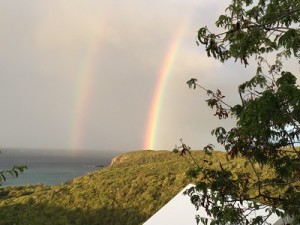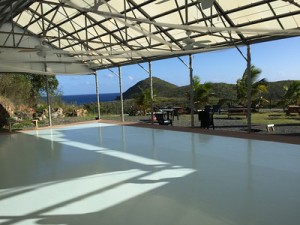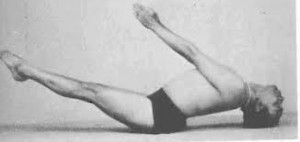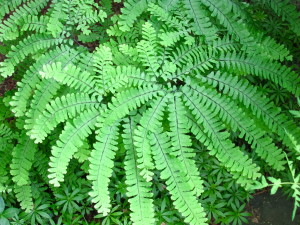Concordia, USVI: Yoga Intensive Vacation, March 3 – 10, 2015
Basic Themes:
Fully inhabiting the present moment, where, in the spiritual heart center, the world of form continuously emerges from infinite, timeless presence.
Locating the heart center as our primary focus, where, resting in the infinite stillness, we allow a 3 dimensional/radial expansion to arise.
Inhabiting this emergence in 4 dimensions: three spatial plus sustained attention through time as 4th dimension.
Finding radial expanding and condensing as a balanced double action, like yin/yang.
Finding the three primary axes through the heart: vertical, horizontal, depth (front to back).
Along the vertical axis, aka the ‘chakra line’, expand beyond 1st and 7th chakras into a sphere of energy/light
Find ascending and descending currents through heart center and beyond, connecting heaven, earth and you.
From heart, feel ascending energy through crown chakra, linking heart to the heavens, Father Sky, the “celestial realms”. Inviting your personal angels and other celestial beings to join you and assist you on your journey of awakening.
From heart, feel descending energies through root chakra, linking heart to Mother Earth, the ‘underworld’. Inviting your personal earth spirits, animal, mineral, and plant, and any other earthly spirit beings to join you and assist you on your journey of awakening.
Your linking of your heart to heaven, earth and the beings here to support you is your first refuge when life sends its challenges and traumas. Cultivate your ‘resources’ so they will be available when you need them.
From the heart open link form heaven to earth and earth to heaven, with heart as the center of balance, completing the Trinity, Mother/Father/You
From the heart, light up each of the other 6 chakras. We will explore how they can support effortless movement and thus lead to deeper layers and levels of integration.
Perception comes before action in beginning. Eventually action/perception/intelligence flow simultaneously as a single conscious movement, like driving a car.
The Sanskrit word for this intelligence is ‘buddhi‘, for the integration of action, perception and the buddhi is Samyama.
Recognizing/embodying the reality that pelvic flexion and extension can act independent of spinal flexion and extension, i.e. hip joints. This will lead to simultaneous groin depth and length.
Lateral flexion/extension/ fish body.
Spiralic action and how this creates expansion.
Where do you inhabit your body? What areas are left out?
Finding fluidity/water
How do the chakras relate to movement? There are psychological, emotional, physiological aspects to the chakras, but we will focus on movement.
The following is a summary of what we worked on during the week, or were supposed to have worked on, or what we might get to some time in the future, with some blanks where my brain just sees emptiness. Thanks to Michael Kirschenbaum for the double rainbow photo.
The Classes:
Monday AM: Optional Silent Meditation: 6 – 6:40 am daily
Opening Guided Meditation:
Sitting comfortably, bring your attention to your heart center, and let is rest there.
Feel/imagine/allow an expanding energy to emerge from the heart center, independent of breath or any other inner movement. Sustain this feeling of expansion.
Find the stillness at the root of the expansion and rest there. Stabilize this. Cultivate the skill of resting in stillness.
From the heart find your chakra line extending through you, linking heaven and earth.
Consciously send your heart energy down through your root chakra into Mother Earth, sending love and gratitude, and receive in turn the love of Mother Earth returning to you.
Consciously extending your heart energy through your crown chakra up the Father Sky, sending love and gratitude, and receive in turn the love from Father Sky.
From the fullness of your heart, light up your chakras, cells, organs, blood vessels, nerves, glands and other structures. Feel the aliveness as vibration.
Bring your hands into namaste in front of the heart. Let the OM emerge from this inner vibration and allow it to amplify and expand inside the body. Sustain sound to enliven heart even more. Feel the stillness as the completion of OM. Repeat 3 times.
Asana: 1st Chakra: Linking heart to feet in standing poses, dog poses and beginning inversions; moving from and through legs and tail
Standing in a relaxed tadasana, find:
Space: feel an expanding energy emerging from the heart center; allow it to meet the tissue where there is a shaping taking place. What is the shape and quality of this meeting, this relationship? We are looking for ‘tensegrity’, the balance of tension and compression, of yin and yang, as a dynamic dance.
Double action: how to have two ‘opposing’ energies cooperate and integrate into a single conscious movement in the entire body.
The spinal axis aka chakra line, opening root chakra to connect to Mother Earth, opening crown chakra opening to father sky. Find heart as center of balance of heaven, earth and you.
1st chakra: Along the vertical axis, aka the ‘chakra line’, expand beyond 1st and 7th chakras into a sphere of energy/light feet, legs and tail. How do they participate in movement? Grounding, stabilizing, initiating.
Tadasana: heart to feet, relaxing / expanding soles of feet like heart center, ankles, knees, hips in harmony of flexion/extension: skiers tadasana. Feel the pose as flow.
 Prasarita Padottanasana: grow a tail to counterbalance torso as you rotate around the hip joints, up and down fluidly, slowly, effortlessly, feeling chakra line fluid like a snake, not stiff like a broomstick!
Prasarita Padottanasana: grow a tail to counterbalance torso as you rotate around the hip joints, up and down fluidly, slowly, effortlessly, feeling chakra line fluid like a snake, not stiff like a broomstick!
Explore: trikonasana/parsvakonasana/ardha chandrasana: fish body poses: reference points: Heart space, inner back heel, front big toe and inner knee, space between femur and pelvis, space in center of pelvis to open tail. Move fluidly, at your own pace. Adjust distances from your perception.
Dog pose and variations: classic dog; one leg dog; flipping dog, in ward and outward, flowing between up and down dog; adding pigeon to previous action.
Dog pose inversion: Using wall, starting form one leg dog, elongate into one leg  handstand, flex and extend up leg, towards half scorpion.
handstand, flex and extend up leg, towards half scorpion.
Sirsasana: coming up from one leg, from two legs: discover variations as upside down standing poses: eka para, parsva eka pada, etc.
Bridge pose on block as prep for Sarvangasana. Find double action.
Go to sarvangasana; support as needed. Add drop back to bridge, halasana, and any other variations that ring your bells.
Lying twist
Savasana
Monday PM: Opening heart space; Hebb’s Axiom and habit in breathing patterns; differentiating ribs and diaphragm, ribs to pelvis, feet to diaphragm; 1st chakra in breathing; beginning pranayama.
(***Important note on ‘diaphragmatic breathing’. Tension, anxiety and stress can cause the diaphragm to become stuck, which creates all sorts of problems. The unconscious response to this is to pull up on the ribs to create some room, a very effortfull and highly inefficient approach to breathing. So ‘diaphragmatic breathing is taught to help people release the diaphragm so it can begin the breathing process of inhalation. In diaphragmatic breathing, inhalation is driven by the diaphragm, not the ribs. We are moving to a more subtle approach to breathing known as pranayama.
We want to encourage more expansion of ribs and chest wall for inhalation, more squeezing of abdominal wall on exhalation to help stretch the diaphragm. The average, untrained body will inhale only from the diaphragm and exhale by collapsing the chest. You can see this pattern in the average middle age pear shaped body, where the belly sticks out (from inhaling down with the diaphragm, and the chest collapses inward and hangs. The diaphragm gradually becomes shorter and tighter as the rib cage becomes smaller. We are looking to carefully transform this pattern.
Lying on floor, follow your breath. Just notice what moves, what contracts, what relaxes, where there is sensation. Notice these in the four stages of the breathing cycle: inhalation, pause after inhalation, exhalation and pause after exhalation.
Now, Using your hands on the side ribs to guide, imagine the inhalation is driven by a sideways expanding of the ribs, the way a bird would open her wings. On the exhalation, do not lose this expanding energy, but add a squeezing of the abdominal wall in and up to lift the diaphragm up into the expanded chest, pushing the air out of the lungs. This feeling of exhaltion can be felt on long OM’s where the sound shapes the chest and diaphragm. Repeat for several breaths, resting if the breath becomes strained. The ribs will release a little bit, but over time, the volume of the chest will expand and remain after exhaltion because the diaphragm is providing lift through the heart center. (See opening meditation.)
Now, imagine pelvic bones expand along with the ribs on inhalation, so the expansion fills the whole torso. On the exhaltion, again, squeeze the abdominals and stretch the dome of the diaphragm up high into the chest to push out the air. Exhalation requires a conscious effort and practice. Your body never really tells you to exhale! It does demand inhalation when the CO2 levels in the blood reaches a threshold. But you cannot get much oxygen into lungs filled with stale air. This is the challenge of asthmatics and those with COPD. More efficient and longer exhaltions allow the lungs to be replenished with oxygen more easily.
 Now add the legs. Imagine you will make a ‘snow angel’ as you breathe. Not only do the arms expand out as you inhale, but so do the legs, to help open the volume of the whole body, but especially the chest. Feel your tail lenghtening nad the 1st chakra opening to receive the breath. On the exhalation, arms legs and abdominals squeeze in, but the chest wall remains as expanded as possible to further stretch the diaphragm way up into the chest. Exhaltion flows from feet to heart and out the nostrils.
Now add the legs. Imagine you will make a ‘snow angel’ as you breathe. Not only do the arms expand out as you inhale, but so do the legs, to help open the volume of the whole body, but especially the chest. Feel your tail lenghtening nad the 1st chakra opening to receive the breath. On the exhalation, arms legs and abdominals squeeze in, but the chest wall remains as expanded as possible to further stretch the diaphragm way up into the chest. Exhaltion flows from feet to heart and out the nostrils.
Now, sitting comfortably, or lying down if that works for you, begin Ujjayi breathing, sustaining the awareness and sensations you have discovered.
Ujjayi I: long, slow, deep inhalation, normal soft exhalation. Focus on lengthening the in breath without losing control of the outbreath. Keep eyes, ears, brain, soft and quiet. No effort from facial muscles, neck muscles or throat. Slight dropping of the head if sitting without collapsing the throat chakra. Skull bones soft and receptive. Continue for 10 minutes or your capacity.
Ujjayi II: normal inhalation, long, slow, deep exhalation. Focus on lengthening out breath. Pause after exhaltion should be soft and natural. If the inhalation comes suddenly, you’ve exceeded your capacity. Continue for 10 minutes or your capacity. Feel free to add normal cycles at ay time. Each breath is a unique experience.
Savasana
 Tuesday AM: 2nd chakra,: moving from and through pelvic bones and sacrum.
Tuesday AM: 2nd chakra,: moving from and through pelvic bones and sacrum.
Guided meditation (see above)
Asana: tadasana, from heart, find legs, awaken what needs to wake up.
prasarita padottanasana (grow a tail); get inside the pelvis to lengthen into tail, then feel left and right pelvic bones by subtly shifting weight from
one side to another. Now widen through center of pelvis, opening across sacrum. Sustain attention here (2nd chakra) as a center of movement. Explore coming in and out, sustaining, dog pose arms also.
Take this action to hanging from barre with belt. Elongate through groins and tail, then widen to release fish body/tail from legs
Half moon to deepen groin space and differentiate the two illia. Then rotate between half moon and revolved half moon to find the illium/pelvic bone as it moves over the femur head and differentiate the two sides. 2nd chakra still the movement center.
Same in down dog / flipping dog. Sustain movement from 2nd chakra.
Trikonasana to parsvottanasana: release back foot/heel to free up sacrum/2nd ckakra as center of rotation. Pause: Continue to parsvottanasana as simple forward bend, but be careful to stay centered in 2nd chakra. Because the two legs are very different, it is difficult to stay balanced in chakra 2.
Continue to revolved triangle: release back foot as necessary to clear hips. Both forward bend and rotation are now required, each challenging the 2nd chakra to stay centered. Beginners can do the revolved triangle without the forward bend so it is more like throwing a frisbee.
Revolved parsvakonasana: same as revolved triangle, however watch for collapse of inner front groin. The inside of the pelvis has to stay open or else the body has to compress to complete the pose.
If the outer and inner hips are both restricted, let from foot and knee turn out and the arm on the floor walks in the opposite direction, so the torso is 90 degrees to the front leg, not parallel.
Sirsasana and variations. Stabilze chakra 2 as the legs change position. Most students collapse the 2nd chakra to drop the leg
Bridge pose on block to open 2nd chakra.
Transition to sarvangasana and variations, stabilizing 2nd chakra
transition poses to savasana.
Tuesday PM: Role of Glutes to open 2nd chakra, linking hamstrings and erectors and opening deep front line through 2nd chakra. Continuing pranayama.
The primary 2nd chakra restrictions to movements involve the illiacus and piriformis muscles, both of which connect to the femurs; illiacus to lesser trochanter, piriformis to greater trochanter.
In tadasana, relax ankles knees and hips into slight flexion, and then activate the gluteus to help extend the pelvis. Place your fingers inside the upper illia a to find the iliacus and pull up toward heart as the gluteus fire. Feel the inside of the pelvis opening like a bow string.
From salabhasana, activate glutes to lengthen spine without over working lumbar or hamstrings.
Dhanurasana, gluteus to open chest as well.
Vira I beginning phase: activate from leg glute. Back leg is easier but keep it engaged also. Open the chest from this support.
Ujjayi pranayama with antara kumbhaka:
Part 1:
Sit comfortably, widening pelvis, grounding energy, opening chest.
Open heart space and feel this as the primary action.
Add expansion of ribs on inhalation; pause part way, before full in breath and suspend the breath, balancing the urge to inhale and the urge to exhale into a quiet inner presence.
Let the back of the skull widen and lift a bit, dropping the brain into the heart. This is an inner jalandhara bandha. Do not pull the chin down! It will just jam up the 5th chakra.
Then allow a soft exhalation to flow into a natural pause. Repeat. Variables are the volume of air taken in, and the duration of the pause. The exhalation should be relaxed, other wise
you have exceeded your capacity
If comfortable, inhale 2/3 full and pause before exhalation, as above.
If comfortable, full inhalation and pause.
During retentions, watch for tension creeping or (roaring) into eyes, ears, neck, spine, throat. these are signs of having exceed your capacity.
Back off on the volume and or duration of the pause.
Part 2: Same as above, this time during the pause add a subtle lift to the top center of diaphragm, just below the back of the heart. This is a mini uddyana bandha. Heart center expanding as the brain and navel move to the heart in stillness. This is the inner pranayama. Not muscular, not will power, no force. Clarity, simplicity and surrender.
Savasana
Wednesday AM: 3rd chakra; Samana Vayu, integrating movement of lower and upper limbs, as in mammalian movement.
Opening meditation: See Monday
3rd chakra is a mediator between upper and lower limbs in movement: feel as 2nd and 4th chakra continuously moving away from 3rd, in all poses, at all times.
Find 3rd chakra of foot – while sitting, massage/open sole of foot, take your time, just do one side – then stand and feel connection to 3rd chakra in torso, near bifurcation of aorta up to under the diaphragm. Bend forward and come up feeling the energy flow from 3 down to pelvis and up to heart. Repeat for other foot.
Hang from barre: feel double action from 3
Use barre for arm support in Vira three: keep pelvis level if possible, extend to ‘plank’ chest/arms and Ardha Chandrasana legs
From Vira III, take up leg and bend it into chest, rounding back, dropping head, like a cat flexing. then extend chest/head and pelvis/leg in opposite direction, as if running.
Repeat in down dog – one leg dog – flip dog – down dog to up dog, all the time monitoring the balancing actions of 3rd chakra. Do not lose either center (chest/pelvis), but keep them both alive and
integrating.
Salabhasana: extend from 3 evenly. Imagine you are running to keep back muscles from tightening. they will have tone !
Add Glutes to open front of pelvis as in Tuesday PM
Ardha supta virasana to open quads more. Stand if knee not happy
Natarajasana with belt to complete loop
padangustha dhanurasana with belt or dhanurasana if need be
down dog
lying twist
savasana
Wednesday PM: 3rd chakra continued
Forward bending from 3rd chakra: not compressing 3rd by collapsing, but keeping 2 and 4 moving away from 3 at all times.
Uppavistha konasana: lengthen through tail into lumbar backbend without engaging erectors while heart enter lifts forward and upward. Sit on height, or lean back if necessary to feel this double action.
Janu Sirsasana into Maha Mudra: Bend the left leg and repeat as above. Then add maha mudra: inhale fully, pause, lift the diaphragm back and up to further expand chest. Allow head to drop without collapsing the neck while hold the breath. Relax with exhalation. Repeat several times to open diaphragm. Feel 3rd chakra organs (liver, stomach, kidneys, spleen charging with energy. Then reverse legs and repeat.
Janu sirsasana forward bend. Retain dynamic 3rd chakra as in maha mudra without retention.
Ardha Baddha Padma Pascimottanasana: first as twist, then forward bend. Retain 3rd chakra charge.
Viloma Pranayama: I and II
Viloma breath allows several pauses on the way to full in breaths and out breaths. These pauses offer a multitude of possible explorations ribs, diaphragm, belly, spine and retentions.
Thursday AM: 5th chakra (Spectacular double rainbow appears as a greeting from the celestial realms)
Once we have integrated, to some extent, chakras 1 through 4, the grounding and rising energies create a foundation for the opening of the throat, neck and mouth.
For most students, the heart energy does not have enough inner lift to support the sternum and 1st ribs. Then, the head and neck muscles take off on their own.
We need to over-ride that pattern and reestablish a link to the lower chakras to support the neck and skull.
Tadasana: build from earth/feet to heart, feel throat/neck softening lengthening. The inhale and exhale, sweeping arms through full circle out to sides and over head,
releasing shoulders from heart center so the neck and skull can relax. Arms/shoulders do not begin in the head/neck/outer muscles of the shoulder such as deltoids and traps. They begin from the rising energies of the lower chakras flowing through heart and into arms.
Prasarita Padottanasana: Recreate running cat action, oscillating between back bending through head and tail to flexing form head to tail. (From beginners cat stretch if necessary to feel).
Feel the emergence of the head as a lengthening of the whole core line, especially in the spinal extension. then walk feet closer together, hold big toes, repeat.
(padangusthasana).
Then, walk feet closer, stand on hands, baddha hasthasana, extend and flex.
Plank Pose: establish 4th chakra sphere, lengthening down through arms, sideways, and through head and tail. Proceed into down dog without losing the length forward through arms and head.
Then up dog making sure heart energy is sufficient to open throat and 5th chakra.
Ustrasana: head on ballet barre to ground and support skull. Draw energy up through heart into skull to release 5th chakra and open 6th. Glutes active to open hips and keep the inner line alive ad lifting.
Shoulder rotation interlude, then: Natarajasana: with belt. Open heart
Sirsasana: with variations if desired: sustain length through 5th chakra. Do not compress the neck!
Sarvangasana: variations and drop backs. Do bridge on a block if necessary to find length through 5th chakra
Savasana
Thursday PM: 5th chakra continued
Supta Padangusthasana: Use long belt, wide arms to link heart center through arms and belt to foot. Lengthen hamstrings from heart, check in to each chakra, 1 – 7, opening.
Go further is possible, repeat through chakras, relax. Repeat though as many cycles as comfortable. Then change legs. Repeat.
Parsva Supta Padangusthasana: Same as above, leg to side; more difficult to keep chakras aligned and open.
Like viparita karani, Pelvis on block, let the limbs float around like an anemone. Be moved by the inner world and its currents
Janu Sirsasana Twist: Feel the inner currents, as in the ocean, moving you into the pose. Allow the current to oscillate, like in the ocean, to the right, then the left, fluidly, organically
Ardha Baddha Padma twist: draw lotus leg parallel to straight leg. If shoulders are open, hold foot.
Marichyasana III: when outer line is at its edge, melt inside, do not fight the tightness
Urdhva Upavista Konasana with belt
Viparita Karani, feet belted at metatarsals to activate outer line.
Savasana
Friday AM: Sixth Chakra
 Opening meditation (see Monday)
Opening meditation (see Monday)
We are visited by a guest teacher, Ms Cattle Egret, who demonstrates neck and skull integration through core opening.
Lie on floor, knees bent: find a neutral skull, neither flexed nor extended. Press back of skull into flopr, release neck vertebrae up and into front body, especially C-1, the axis. Find this joint, where the neck and skull meet. Grow the occiput backwards and C-1 forward slightly.
Recreate in tadasana: connect inner ears to feet, as if feet support inner ears so they can float/release up carrying skull as if it were a baloon with helium
Recreate in trikonasana, this time use your hand to guide/support the extension through the inner ears, especially the bottom or front leg ear. Connect inner ears to groins, inner back heel and tail.
Recreate in parvakonasana and ardha chandrasana.
Down dog, head on block to take pressure off neck muscles. Find inner ears and release. widen.
Ustrasana, head on ballet barre, more vertical to begin, rest skull on barre, open inner ears.
Natarajasana: open inner ears through groins, feet, tail and arms.
Sirsasana: Feel grounding through skull bones as well as forearms
Viparita karani / sarvangasana with variations, especially drop backs to open inner channels between 5 and 6.
Sustain in halasana and variations
Savasana
Friday PM: 6th chakra continued
Hanging dog from ballet barre. Lengthen core away from barre through finger tips. retaining length. Come unto bowsprit pose, extending hips fully, keeping groin length.
Repeat coming upend back down, lengthening like spinning out pizza dough. Let you collagen be like gluten.
Standing twist with barre. One leg forward, one back like parsvottanasana, launch the upstroke from sole of back foo, ride wave up through core into heart as a rising spiral the spins out into arms and hands like throwing a frisbee. Do not let the arms race off ahead of the action. Uncoil like a fiddler head fern. The heart has to be fed from below to then feed the uncoiling of the arms from the core.
Hanging dog from barre.
Standing 1/2 drop back from barre with belt. Glutes max, use the legs dynamically to protect spine from contracting. Lengthen!
Sama vritti pranayama: balance the four phases of the breath: inhalation/ pause / exhalation / pause … repeat.
Pauses are retentions. Remember volume and duration to not exceed your capacity.
Savasana
Saturday AM: 7th chakra emerges as the integration of the first 6 deepens. Movement comes from the tip of your ‘conehead’.
Opening meditation: (see Monday)
Creating groin depth and length:
Find feet in tadasana, ankles and knees slightly flexing, keeping pelvic bones vertical as you rise and fall. If the pelvis tilts, there is an imbalance.
On hands and knees, cat pose: flex and extend fully from head to tail like a cat running. Then find neutral, just from pelvic bones, sitting bones down to meet pubic bones and, simultaneously, pubic bones down and back to meet sitting bones, like a pelvic namaste. Outer body still, inner body vibration. Where to two movements meet, find the root of the perineum, holding that in vibrant stillness, lengthen through head and tail and beyond. Sustain this energy line. Recreate in tadasana.
Tadasana: block between upper inner thighs. Roll block backwards through internal rotation and slight pelvic flexion with pubic bones, hold block still and activate gluteus to extend pelvis from sitting bones, without moving block. Feel the same action as in cat pose.
Trikonasana: same pelvic action as you deepen groins. Legs as wide as possible. Use pelvis, tail and back leg inner heel to deepen the front groin.
Ardha chandrasana: use support if necessary. Same as trikonasana: use tail, pelvis and back leg to open front groin. Come as far down as possible, bending front elbow.
Urdhva prasarita ekapadasana: From ardha chandrasana, keep extending back leg while the pelvis rotates back to neutral. Stay in a deep forward bend while still elevating the back leg higher and higher. As the back leg lifts, let the pelvis float up off of the femur to deepen the groin action.
Sirsasana: Come up with one leg like urdhva pras. ek. Create so much groin depth and length that you lift up lightly.
Sirsasana variations: eka pada, parsva eka pada, others, using groin length and depth.
If not doing sirsasana, down dog to one leg dog, creating groin depth and length.
Uttasana/prasarita padottanasana: deepen groins further by finding groin gates: heels in/ toes out opens front groin gate at pubic bones/femoral triangle. Heels wider, toes in opens back groin gate at the tail/sitting bones. Let the ribs come closer and closer to the thighs as the groins open.
Bakasana: keep the groins deep and open, squat, upper arms pressing out into inner  thighs, inner thighs squeezing into upper arms. Plant the hands, find the balance and lift into bakasana.
thighs, inner thighs squeezing into upper arms. Plant the hands, find the balance and lift into bakasana.
Belt flexed legs together to prevent the old habit of trying to extend the legs. Feet on blocks for this struggling to achieve lift off.
In bakasana, find third chakra as center of lift as core lengthens. Try tittibhasana or other arm balances. Jump back from bakasana to chaturanga or plank.
Bridge on block, open deep front line if it has contracted during the extended bakasana.
Roll up to matsyasana by extending through tail until heart and shoulders lift and skull rotates back. Remove block if necessary.
 Extend arms and legs diagonally ipward while still in fish. This is called uttana padasana …..
Extend arms and legs diagonally ipward while still in fish. This is called uttana padasana …..
viparita karani
savasana
Saturday PM: Groin length and depth in seated forward bends. Ujjayi pranayama
Uppavistha konasana: Sit with legs extending, take hands on floor behind to lengthen groins and spine. As you begin to bend forward, from groins, lengthen spine from sacrum forward and tail backward to create simultaneous length and depth. As soon as groin begins to shorten, pause. In full forward bend the spine returns to its C-curve, but the groins stay long and open.
Uppavistha, rotate to right leg, repeat as above. Rotate to left leg, repeat as above.
Janu Sirsasana: Bend left leg to side, turn toward the right leg, extend groins/core as you bend forward. Double action, back through root chakra, forward through crown, all the way.
Urdhva Pascimottanasana: Slight support for tail or pelvis, lengthen groins out through tail, up through crown. Let spine softena release into the natural ‘C’ curve.
Ujjayi pranayama (or any other): Work on anything that has come up for you. Keep the groins long as the breath opens the body more and more.
Savasana;
Finis
 Homework for all of us!
Homework for all of us! 8. Same with trikonasa – parvakonasana – ardha chandrasana – other standing poses.
8. Same with trikonasa – parvakonasana – ardha chandrasana – other standing poses.











